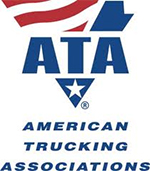U.S. Regulators Are Seeking To Forcibly Limit How Fast Trucks Can Travel On Highways

A plan jointly released by the National Highway Traffic Safety Administration and Federal Motor Carrier Safety Administration would put a cap of anywhere from 60 to 68 miles per hour on vehicles over 26,000 pounds.
Department of Transportation (DOT) Secretary Anthony Foxx announced last week that the National Highway Traffic Safety Administration (NHTSA) and Federal Motor Carrier Safety Administration (FMCSA) want to propose equipping heavy-duty vehicles with devices that limit their speeds on U.S. roadways.
Although the government is not saying exactly what the top speed of the governors would be, the proposed ruling would require those devices be set to a maximum speed.
Foxx says the safety measure that could save lives and more than $1 billion in fuel costs each year.
“There are significant safety benefits to this proposed rulemaking,” Foxx said.
“In addition to saving lives, the projected fuel and emissions savings make this proposal a win for safety, energy conservation, and our environment.”
The DOT proposal would establish safety standards requiring all newly manufactured U.S. trucks, buses, and multipurpose passenger vehicles with a gross vehicle weight rating more than 26,000 pounds to come equipped with speed limiting devices.
The rule would not require retrofitting of older trucks.
The proposal discusses the benefits of setting the maximum speed at 60, 65, and 68 miles per hour. But Foxx said the DOT “will consider other speeds based on public input.”
The American Trucking Associations (ATA) hailed the proposed rule as “a potential step forward for safety,” setting up a fight with the owner operators, who oppose the proposed rule.
“We are pleased NHTSA and FMCSA have, almost 10 years after we first petitioned them, released this proposal to mandate the electronic limiting of commercial vehicle speeds,” ATA President and CEO Chris Spear said.
“Speed is a major contributor to truck accidents and by reducing speeds, we believe we can contribute to a reduction in accidents and fatalities on our highways.”
Since 2006, ATA has adopted a policy in favor of limiting the maximum speed of new trucks to 68 miles per hour. Later that year, the ATA petitioned FMCSA and NHTSA to issue a regulation requiring their use. In 2008, as part of ATA’s 18-point highway safety agenda, the federation endorsed a national speed limit of 65 mph for all vehicles.
“As an industry, we cannot be afraid of technology, but we also must make sure that technology has proven benefits,” Spear said.
“Carriers who already voluntarily use speed limiters have found significant safety, as well as fuel efficiency and equipment lifespan benefits with little to no negative impact on productivity. We will be carefully reviewing and commenting upon today’s proposal.”
Motor carriers operating commercial vehicles in interstate commerce would be responsible for maintaining the speed limiting devices at or below the designated speed for the service life of the vehicle under the proposal.
While the maximum set travel speed will be determined in the final rule, estimates included in the proposal demonstrate that limiting heavy vehicles will save lives.
“This is basic physics,” said NHTSA Administrator Mark Rosekind. “Even small increases in speed have large effects on the force of impact. Setting the speed limit on heavy vehicles makes sense for safety and the environment.”
Other government officials said the DOT proposal was an efficient compromise between improving truck safety and ensuring efficient surface freight transport around the nation.
“Safe trucking moves our economy and safe bus operations transport our loved ones,” said FMCSA Administrator T.F. Scott Darling, III.
“This proposal will save lives while ensuring that our nation’s fleet of large commercial vehicles operates efficiently.”
The proposed ruling sets up yet another fight between owner-operators, which are against the governors, and the organized trucking industry, which is in favor of the speed limiters.
The Owner-Operator Independent Drivers Association (OOIDA) says it is against the speed limiters for various reasons. OOIDA says it opposes anti-competitive measures such as speed limiters that are falsely promoted as safety initiatives. It says it is against the new rule for three reasons:
- According to DOT data, less than 8% of fatal crashes involving trucks are speeding-related, compared to almost 30% for passenger vehicle crashes.
- Speed limiters for trucks would result in a significant speed differential between cars and trucks on roads like Interstate highways.
- Speed differentials lead to conflicts between cars and trucks, which lead to crashes. Most states have done away with posted speed differentials due to increased accidents with cars and trucks.
Article Topics
American Trucking Associations News & Resources
Trucking industry balks at new Biden administration rule on electric trucks: ‘Entirely unachievable’ Groups warn of $1 trillion cost for electrification of America’s trucking industry New coalition is focused on fighting new Labor Department independent contractor rule ATA data points to truck tonnage declines to start 2023 December Truck tonnage ends 2023 with a modest gain, reports ATA ATA warns of ‘tangled mess’ due to latest Labor Department independent contractor ruling November truck tonnage is down, reports ATA More American Trucking AssociationsLatest in Transportation
Baltimore Bridge Collapse: Impact on Freight Navigating Amazon Logistics’ Growth Shakes Up Shipping Industry in 2023 Nissan Channels Tesla With Its Latest Manufacturing Process Why are Diesel Prices Climbing Back Over $4 a Gallon? Luxury Car Brands in Limbo After Chinese Company Violates Labor Laws The Three Biggest Challenges Facing Shippers and Carriers in 2024 Supply Chain Stability Index: “Tremendous Improvement” in 2023 More Transportation















